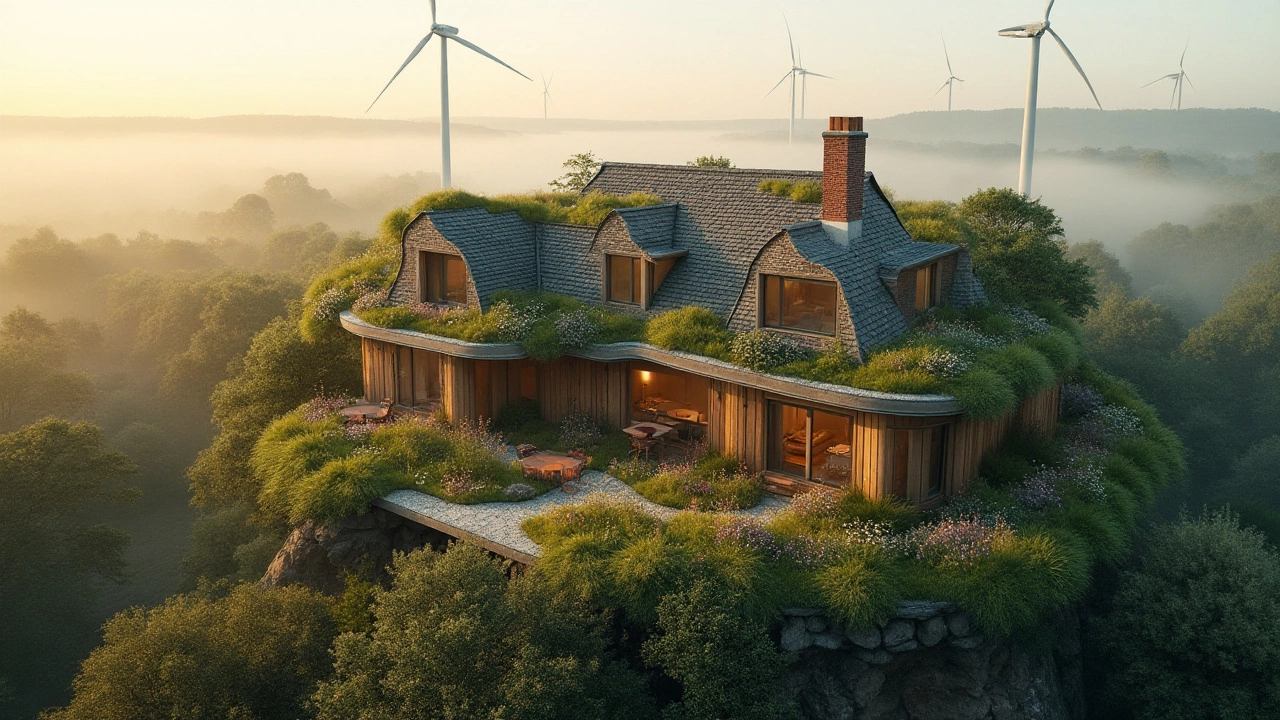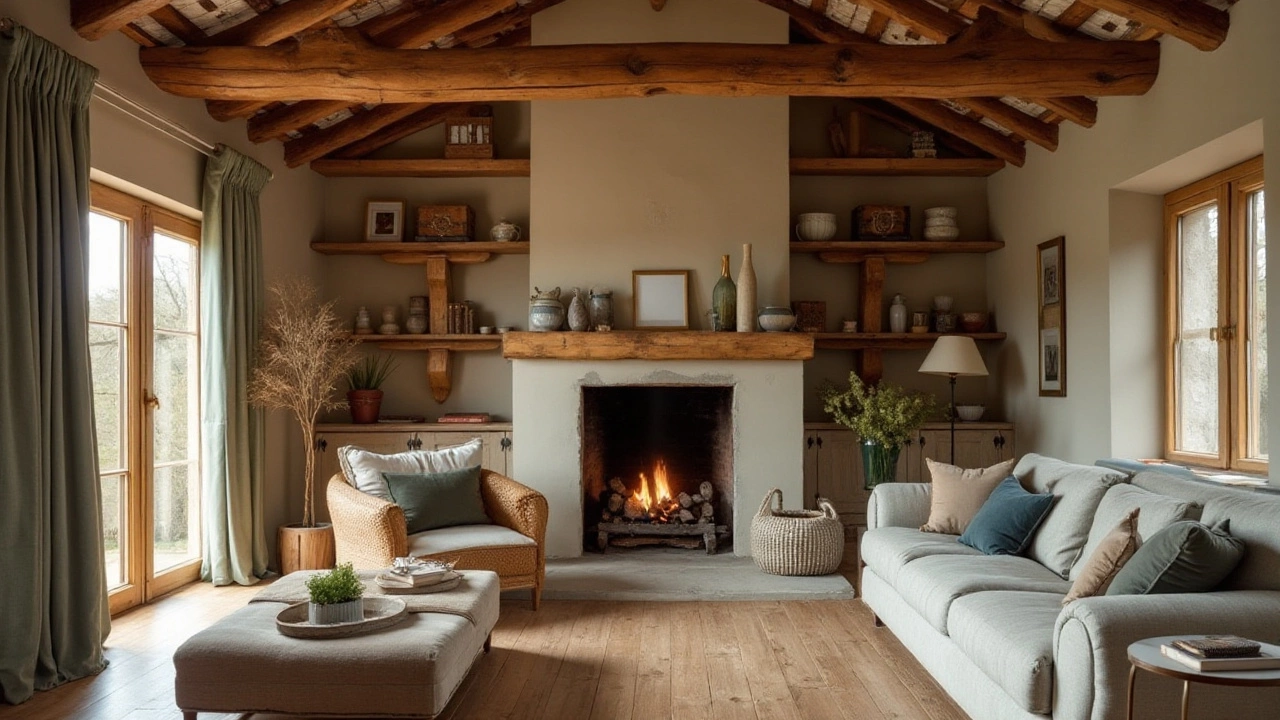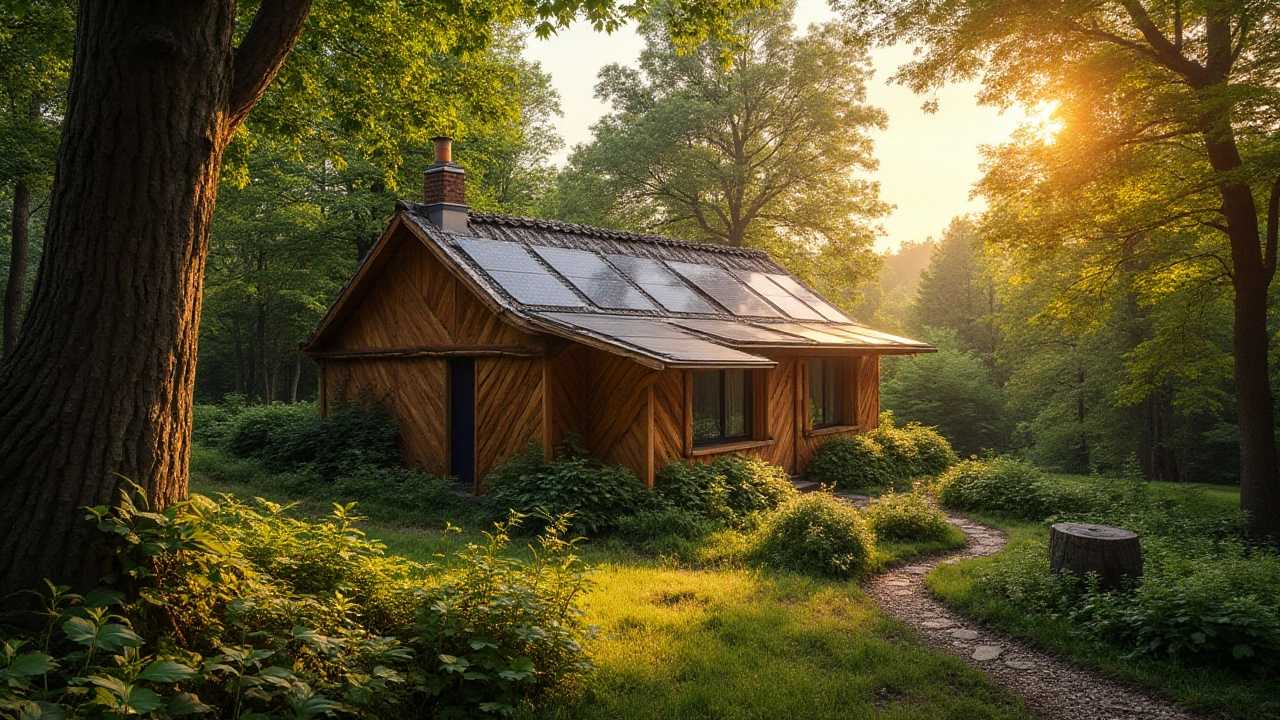Eco-Friendly Cottage Construction: Building a Greener Future
29 Jan, 2025The drive towards green living has revolutionized how we see and build homes. Eco-friendly cottages have emerged as a stunning convergence of sustainability, efficiency, and charm. At the heart of these eco-conscious abodes lies the use of sustainable materials and ingenious design principles that significantly cut down environmental footprints.
One of the key aspects when building such a house involves selecting materials that not only minimize waste but also rejuvenate our surroundings. Think of bamboo, a fast-growing plant that surprisingly outpaces traditional timber in both growth and strength. Or consider the rustic allure of reclaimed wood, repurposed to give serene, inviting interiors. The styles vary, yet the thoughtfulness remains consistent.
- Sustainable Materials
- Energy-Efficient Design
- Renewable Energy Integration
- Small Space Design
- Smart Technology Implementation
- Building with Nature in Mind
Sustainable Materials
When it comes to constructing eco-friendly cottages, sustainable materials play a pivotal role. Understanding which materials are not only durable but also environmentally conscious can transform a simple structure into a beacon for sustainable living. A great deal of innovation in recent years has given rise to materials that are both aesthetically pleasing and ecologically sound. One shining example is bamboo. This remarkable plant grows at breakneck speed, often reaching full maturity in just three to five years. Its strength rivals many conventional woods, making it a practical and eco-friendly building material. Additionally, bamboo plantations absorb more carbon dioxide and produce more oxygen than any equivalent stand of trees. This characteristic enhances its role in the fight against climate change.
Another intriguing option is hempcrete, a composite material made from the inner fibers of the hemp plant mixed with lime. Hempcrete boasts an intriguing set of properties: it provides excellent insulation, is fire-resistant, and can help regulate humidity within the home, creating a healthier living environment. It's also incredibly light, reducing the carbon costs of transporting raw materials to the construction site. Hemp grows like a weed—literally—and can be harvested in just a few months, making it a rapidly renewable resource.
"Utilizing sustainable materials contributes not only to the longevity of our planet but also streamlines costs over time," says Dr. Amelia Ross, a leading expert in sustainable architecture. "The trick is to balance upfront investments with long-term savings and environmental stewardship."
Reclaimed wood is another increasingly popular material. It gives old timber a new lease on life, often providing unique textures and colors that enhance the aesthetic value of a home. This type of wood reduces the need for new logging, preserves forest ecosystems, and minimizes landfill waste. Salvaged materials can stem from diverse origins: old barns, defunct factories, or even discarded shipping pallets. This recycling not only spares forests but injects history and character into modern construction.
The art of eco-friendly construction often involves a mix of both the innovative and the traditional. Straw bales, for instance, return to use from a bygone era. Once widely used by settlers in the Midwestern United States, this method provides another viable alternative to traditional bricks and mortar. Straw bales excel at insulation, naturally regulating indoor temperatures by keeping warmth in during the winter and letting cool air circulate in summer. Straw bale building utilizes predominantly local materials, minimizing the carbon footprint associated with transport, and bolsters local agricultural economies.
Consider also the burgeoning use of ferrock, a relatively new green material composed of steel dust and silica. An unexpected advantage of ferrock is its ability to absorb atmospheric carbon dioxide during its hardening process, reversing some of the greenhouse gas emissions. This makes it an excellent substitute for concrete, which is notoriously carbon-intensive. Additionally, ferrock is lauded for its hardness and resistance to cracking compared to its concrete counterparts. As we increasingly seek solutions to urban waste problems, turning industrial byproducts into construction materials with a positive ecological impact is a promising avenue.
These examples merely scratch the surface of what's possible when building sustainably. As we enthuse over natural resources and inventive recycling methods, the ultimate reward comes in knowing that these choices allow us to live in harmony with our planet. By choosing these sustainable building materials, we don't just construct homes; we redefine the concept of shelter, enriching our lives and nourishing the Earth.
Energy-Efficient Design
At the heart of crafting an eco-friendly cottage is the pursuit of energy efficiency, a crucial element that minimizes the ecological impact while optimizing comfort and utility savings. The magic begins with orientation; positioning your cottage to harness natural sunlight reduces the need for artificial lighting and aids passive heating. Large south-facing windows are a common feature, offering warmth and brightness, but equally essential are appropriate shades or tree placements to shield from excessive summer heat.
Insulation takes the spotlight in an energy-efficient design. Materials like sheep’s wool, cellulose made from recycled paper, or even straw bales are gaining favor for their robust insulating properties that perform well against the elements. By creating a tight thermal envelope, these materials play a part in keeping energy consumption--be it heating or cooling--to a minimum. Windows, another critical component, are no longer just pretty views but vital parts of thermal efficiency. Double glazing or triple-pane windows, often filled with inert gases, stand as silent sentinels keeping interiors cozy.
Ventilation, an aspect often overlooked, complements insulation by improving air quality without energy drain. Innovative systems such as the heat recovery ventilator (HRV) capture warmth from outgoing air, transferring it to the fresh air coming in, ensuring comfort and efficiency go hand in hand. One should not underestimate the role of a well-sealed home to prevent drafty leaks that waste your energy savings. According to a report from the National Renewable Energy Laboratory, "A tight building envelope can lower energy use for heating or cooling by 20%."
Complementing the structural elements is the adoption of energy-efficient appliances and smart home systems. Gone are the days of electric guzzlers. Today’s market boasts everything from low-energy LEDs to intelligent thermostats that learn your schedule, optimizing climate control without lifting a finger. As technology advances, these systems work harmoniously to cut down consumption and offer significant long-term savings. Sustainable building often embraces designs that support low-water landscaping, utilizing native plants, and drip irrigation to conserve this precious resource.
For the ambitious, include renewable energy sources such as solar panels or even small wind turbines. While the initial investment might raise eyebrows, the payment dividends through lowered bills and reduced carbon footprints are worth considering. Every so often, technology works hand in hand with nature, like using thermal mass walls that naturally regulate temperature. The energy-efficient design of an eco-friendly cottage emphasizes consideration of our changing climate, championing sustainable living through thoughtful design and technology.

Renewable Energy Integration
When we talk about building eco-friendly cottages, renewable energy sources play a pivotal role. Harnessing the power of the sun, wind, and earth isn't merely an architectural trend—it's a necessity for anyone aiming to reduce their carbon footprint. Solar panels, for instance, have become more accessible and efficient, turning sun-drenched rooftops into miniature power stations. These panels convert sunlight directly into electricity, making them a popular choice to supplement or even replace traditional energy sources. The appeal doesn't just lie in their functionality; the sleek, modern design they've adopted in recent years integrates seamlessly with rustic cottage aesthetics.
Beyond solar panels, wind turbines have seen advancements in scaling down to sizes suitable for homes. Micro wind turbines offer a way for homeowners in breezy locales to generate wind power independently. While these aren't as omnipresent as solar, they provide a nod to the flexibility in choices available for sustainable building. An innovative option for energy integration is geothermal heating, which utilizes the earth's natural temperature to heat or cool the home, offering consistent energy efficiency year-round. This method capitalizes on the ground's insulating properties, significantly reducing the need for external energy consumption.
Integrating renewable energy is not just about choosing the right system; it's about ensuring that these systems work in harmony with other energy-saving techniques. Energy-efficient windows, proper insulation, and strategic house positioning can reduce overall energy needs significantly, optimizing renewable energy use. The combination of these techniques ensures that the household maintains a comfortable climate inside, regardless of the weather outside. One exciting statistic to note is that fully integrated renewable systems in homes can reduce overall energy costs by up to 70%, as suggested by the European Renewable Energy Council.
"Incorporating renewable energy into building designs isn't just forward-thinking; it's an investment in our planet's health," emphasizes James Smith, an expert in sustainable architecture.
Moreover, with the rise of smart home technology, various renewable energy systems can be monitored and controlled through apps, ensuring efficiency and cost-effectiveness. Homeowners can track solar panel output, adjust geothermal settings, and even predict power surpluses that can be fed back into the grid. By embracing these technologies, we not only become energy pioneers but also contribute to the larger aim of reshaping our energy landscape for future generations. There's endless potential when blending traditional cottage allure with cutting-edge energy solutions, crafting a home that is as kind to the earth as it is to its occupants.
Small Space Design
In the realm of building eco-friendly cottages, embracing the art of small space design plays a pivotal role. The allure of these quaint dwellings lies in their minimalistic footprint, encouraging homeowners to rethink the essentials while scaling down consumption. Such an approach doesn't just save on materials and energy—it cultivates a lifestyle of intentional simplicity. In constructing these spaces, every square foot is meticulously accounted for, ensuring that comfort isn't sacrificed, but rather redefined in elegant, innovative ways.
Efficiency becomes the mantra, and every corner has a purpose. Open floor plans often dominate the scene, seamlessly blending kitchen, dining, and living areas into one fluid space. This not only enhances movement but also maximizes natural light, creating an airy, expansive feel, despite a home's modest size. Furniture that pulls double duty, such as beds with drawers or tables that fold away, extends functionality without crowding the area. Sustainability gets woven into the fabric of daily life, capturing the essence of living larger with less.
Discussing small spaces inevitably leads to storage solutions, another cornerstone of effective design. Vertical storage towers over traditional methods, pulling inspiration from urban micro-apartments. Cabinets that reach the ceiling, multi-tiered shelving, and hidden storage nooks turn challenges into opportunities. With clever design, even tiny houses can accommodate the possessions of a full, active life. In many cases, opting for fewer, higher-quality items complements this strategy, further reducing the ecological impact.
"The best way to utilize limited square footage is by prioritizing adaptability," suggests designer Sarah Susanka, who has long advocated for the 'Not So Big House' approach. "A home should reflect who you are and how you wish to live, not how many things you can fit inside."
Looking at the stats, data reveals that heating and cooling accounts for nearly 50% of home energy use, according to the U.S. Energy Information Administration. Downsizing these needs equates to a significant reduction in property carbon emissions. That's why many small eco-homes are outfitted with advanced insulation and energy-efficient windows—meetings of necessity and ingenuity that keep the interior climate controlled without excessive resources. Even habitats nestled into colder climates can benefit from such features.
By championing these strategies, tiny home dwellers often discover an enriched lifestyle, fostering a deep connection with both their immediate and greater environments. The move to smaller living is not just spatial; it's profoundly philosophical, underpinned by a desire to leave an imprint marked by innovation and reverence for the planet. With the right mindset and tools, a small space becomes an expansive domain of transformation, setting an example for green homes worldwide.

Smart Technology Implementation
Integrating smart technology into an eco-friendly cottage is more than just a futuristic move—it's a pivotal step towards achieving greater energy efficiency and sustainability. These smart solutions not only simplify modern living but also make it possible to drastically cut down on waste and resource consumption. For anyone committed to making their home greener, there are several indispensable tools that enhance both functionality and reduce the environmental footprint.
One of the most impactful uses of smart technology is in managing energy consumption. Smart thermostats, for example, have the ability to learn your schedule and adjust heating and cooling in a way that optimizes energy use without compromising comfort. According to the U.S. Department of Energy, using a programmable thermostat can save about 10% per year on heating and cooling bills. When combined with energy-efficient appliances, their potential to reduce carbon emissions is greatly magnified.
Lighting is another area where technology has made significant strides. LED smart bulbs can not only reduce energy use by as much as 75% compared to traditional incandescent bulbs, but they also offer features like remote control and automation, allowing homeowners to control when and where the lights are turned on. These bulbs can be integrated into home automation systems to create lighting schedules that mimic natural light patterns, nurturing a more harmonious lifestyle that aligns with the environment.
Smart water systems are crucial in managing and conserving water use, which is often overlooked in many traditional homes. Installing sensors that detect leakage early can prevent extensive water wastage and damage. Advanced systems can also optimize irrigation scheduling for landscapes around green homes, conserving water while keeping gardens lush. As reported by the Environmental Protection Agency, households can save up to 10,000 gallons per year by simply fixing leaks.
The application of smart technology extends to renewable energy sources as well. Solar panel systems equipped with smart inverters can monitor and optimize energy production. These systems facilitate better use of energy generated by not only adjusting the energy flow but also by storing excess power for use during cloudy days. This smart energy management ensures that homes are operating with maximum efficiency, reducing reliance on non-renewable sources. In some cases, homeowners can even sell excess energy back to the grid, thus supporting broader sustainability efforts.
A notable mention in the realm of smart solutions is the implementation of home energy management systems (HEMS). These systems provide comprehensive monitoring and control over multiple aspects of home energy use, from lighting to heating to renewable energy. With granular data and real-time analytics, HEMS allows homeowners to identify energy hogs and adjust usage proactively. An analysis published by the American Council for an Energy-Efficient Economy states that HEMS can potentially save 15% on household energy bills, highlighting their economic as well as environmental benefits.
The integration of smart home technology into sustainable building projects isn't just a trend—it's a reflection of an evolving mindset toward ecological responsibility and efficient living. The enhancements brought by these technologies create homes that are not only smart and resource-efficient but also comforting and aligned with nature's rhythms. It's an exciting time for those poised to adopt these changes and live in harmony with both technology and the Earth.
Building with Nature in Mind
When contemplating the construction of an eco-friendly cottage, one can't underestimate the significance of aligning the home with its natural surroundings. This harmonious integration not only boosts the aesthetic appeal but also the functionality and sustainability of the building. The practice of building with nature in mind features the strategic placement of the house where it can take full advantage of natural light. This reduces the dependency on artificial lighting and heating, resulting in a substantial cutback in energy costs. By orienting your home to face the sun, especially on its arc in the sky during winter, the structure can receive more light and warmth when it's needed most. It's like turning your whole home into a giant, cozy sunroom. Eco-friendly cottages that are strategically designed to accommodate sunlight and airflow create pleasant interior environments that are comfortable year-round.
Blending with the natural landscape means more than just situating a home in a picturesque spot; it involves leveraging terrain, flora, and even local wildlife as part of the design ethos. For example, using native plants in landscaping not only enhances the sustainability factor but also supports local biodiversity. The plants require less water and maintenance, fostering a resilient ecosystem right in your garden. Cottages that are part of the landscape rather than set apart from it can merge stone, wood, and glass elements that echo the surroundings and make residents feel like they’re part of something grander and deeply connected.
Materials play a crucial role in linking construction with nature. Choosing local and recycled materials such as reclaimed wood or quarried stone can drastically reduce the carbon footprint associated with transportation and manufacturing. In this context, it’s worth noting the rise of earth-based materials like rammed earth and adobe clay, which not only provide thermal mass and insulation but also resonate with the inherent beauty of natural imperfections. These materials bring a tactile connection to nature, retaining earthen colors and textures that evolve over time. A great insight comes from the noted architect Frank Lloyd Wright, who emphasized that, "Study nature, love nature, stay close to nature. It will never fail you." This philosophy encourages designers and builders to fully embrace the resources and opportunities that each unique site offers, crafting a bespoke environment that is sustainable for generations.
On a practical level, blending with nature often results in smarter, greener homes. For instance, integrating rainwater harvesting systems ensures that the site remains almost entirely self-sufficient for water needs. This involves collecting and storing rainwater from roofs for cleaning, washing, or even irrigation. All while reducing dependency on the main water supply. Adding features like green roofs not only insulate the home but also provide habitats for birds and insects, rendering them as vibrant assets to the ecosystem while improving air quality and reducing urban heat. Homes that work in harmony with the natural world are generally healthier and more resilient against extreme weather scenarios, reducing repair costs and enhancing their longevity.
There's an art and science to building with nature in mind, requiring awareness, respect, and the willingness to tread lightly on the earth. Such projects accomplish more than simply offering shelter; they become part of an intricate ecological web, bolstering community ties and enhancing the human spirit's bond with the environment. Strikingly, studies from the University of Cambridge have shown that integrating natural elements into home design can lower stress and improve overall mental well-being, making the case for eco-friendly cottages as hubs of sustainable serenity.

 by
by